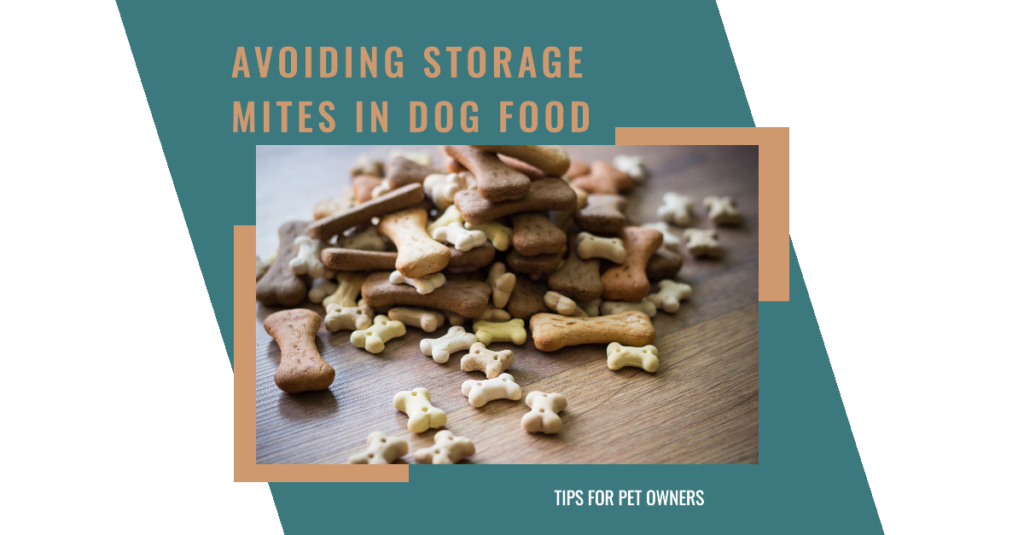Mites that store dry food and grain storage areas can cause allergies. Storage mites are small insects that live in these environments and feed on dried foods such as rice, flour, dog food and fish. If a pet inhales or ingests these particles through its food, it can cause allergic reactions in sensitive animals.
Symptoms found in pets with storage mite allergies include sneezing, coughing, runny eyes and runny nose. They also have red and itchy skin all over their bodies. This article aims to help pet owners understand more about storage mite allergies and also gives inputs on how to Avoid Storage Mites in Dog Food?
What are Storage Mites?

Storage mites are tiny insects that can survive in dried food storage areas for extended periods of time. Household items include sacks of flour and rice. They cannot be seen with the naked eye because they are barely visible, about 0.2-0.4 mm.
Storage mites consume nutrients from grains, flour, and dry goods such as pet food. They thrive in dry, warm climates with plenty of food. Pets can ingest these particles and their food if storage containers contain bacteria.
What signs are you or your pet reacting to food storage mites?
Some common signs that owners should look out for could indicate that their pet is allergic to storage mites. There is coughing, sneezing, runny nose and inflammation of the eyes, causing them to become red, itchy and watery.
Pets often rub their faces because their skin and nose feel irritated. Stretching a rash can cause itching and redness of the skin throughout the body. A cut or scratch usually occurs when the ear feels burned, and your skin feels itchy and uncomfortable.
Some pets may also have experienced digestive issues such as vomiting, diarrhoea, or loss of appetite. Paying attention to any behavioural or physiological changes can help identify potential food allergies early.

symptoms of storage mite allergy in dogs
Symptoms of storage mite allergy in dogs may include:
- Itchy skin (pruritus)
- Red, inflamed skin (dermatitis)
- Excessive scratching or licking of paws and body
- Hair loss (alopecia)
- Ear infections
- Red, watery eyes
- Sneezing or nasal discharge
- Coughing or wheezing
- Gastrointestinal issues (vomiting, diarrhea)
- Respiratory distress (rare, but possible in severe cases)
Common Sources of Storage Mites in Dog Foods
Storage mites grow when dry grains, flour, seeds and pet food are stored for long periods of time. Some of the most common places in homes where these moths can harbour large bugs include pantry dishes, flour dishes, dog and cat food packaging and storage containers.
They especially like to live in small crevices with spilt or leftover dried food. Signs of infestation include microorganisms crawling on or around upholstery or fine powdery dander, small amounts of dirt, or clean skin Can be seen Bedding, upholstery, carpets and soft toys near storage areas can get dirty over time. It is important to be vigilant about pest control in these areas.
Testing for Storage Mite Allergy
It is important for pets exhibiting signs of a possible food allergy to see a veterinarian for a thorough evaluation and diagnosis. Tests may be recommended to identify specific allergens, such as secreted particles that trigger behaviour. Skin tests often detect immediate hypersensitivity reactions, while blood tests can examine long-term allergy antibodies for food allergies.
Experimental food elimination can eliminate suspect foods or drugs, followed by food intake challenges. This elimination process helps veterinarians identify allergens to avoid.
Treatment of Storage Mite Allergy
Once storage ants are confirmed to be the cause, treatment focuses on total avoidance and environmental preventive measures. Any infested food container or bedding should be replaced.
An integrated approach to pest management using biological, physical and chemical methods to eliminate existing bulbs and prevent new pests in the home. Chemicals such as antihistamines and steroids may help alleviate symptoms but do not cure the underlying ulcer.
Dietary management also plays an important role in managing chronic symptoms by switching to a specially prescribed low-particle diet. With continued monitoring and preventative measures, affected pets can have a better quality of life.
Preventing Storage Mites in Pet Storage Containers.
Pet owners need to practice good hygiene and integrated pest management strategies to prevent harbouring fleas from becoming a problem in the first place. Regular vacuuming and cleaning of storage areas and surrounding areas can remove existing particles and spilt food.
Dishes should be washed thoroughly with warm, soapy water and thoroughly rinsed before refilling. Complete drying in sunlight eliminates any remaining insects and eggs. Airtight glass or BPA-free plastic containers with a tight seal help keep the particles out.
Regularly changing or cleaning bed sheets and installing attacks. Early detection and prompt remediation through routine inspections are key to preventing problems with particle storage in hairy family homes. With care and understanding, pets and their parents can withstand tick bites.
what to feed a dog with storage mite allergy?
| Food Item | Portion |
|---|---|
| Hypoallergenic kibble | 1 cup per meal |
| Lean protein (e.g., chicken, turkey) | 1/2 cup per meal |
| Cooked vegetables (e.g., carrots, green beans) | 1/4 cup per meal |
| Limited ingredient treats | Occasional, as a reward |
| Fresh fruits (e.g., apple slices, blueberries) | Occasional, as a treat |
Conclusion
Storage mite allergy is a serious condition that affects many pets. Owners can take better care of their allergic companions by following the causes, signs, and preventive tips outlined here. With prompt cleanings, allergy tests when needed, and dietary solutions, pets can live healthy and happy lives free of pesky fleas. Taking the proper precautions and preventing fleas now and then can help ensure that flea bites remain in our pets’ homes.
Frequently Asked Questions (FAQs)
Q.1: Does all dog food have storage mites?
If you feed your pet a hypoallergenic canned food diet as advised by your veterinarian, your pet won’t be exposed to the storage mites typically present in dry kibble, cereals, grains, and cheese. This could be the solution to your pet’s storage mite problem.
Q.2: How do you stop storage mites?
Keeping the food in its bag and putting it in plastic containers that can be sealed up will help keep storage mites out of the feed. Regularly clean these plastic storage containers, being sure to dispose of any dust at the bottom and always before adding any new food and preserving the food in a dry, cool place.
Q.3: What smell do mites hate?
Compounds in essential oils can either kill or repel insects, including dust mites. Eucalyptus, clove, and rosemary are essential oils for eliminating dust mites. Mix four ounces of witch hazel with twenty drops of oil, then spray your mattress, couch, curtains, and other dust mite hangouts.
Q.4: What kills mites fast?
A skin lotion called permethrin contains chemicals that destroy scabies-causing mites and their eggs. Adults, those who are pregnant or nursing, and kids older than two months old are considered safe using it.
Q.5: How do you clean a dog with mites?
The mites can be removed with an apple cider vinegar soak in water. Combine ½ cup Borax, ½ cup apple cider vinegar, and a small amount of warm water. Before spring, the mixture onto your dog’s skin and coat, ensuring the borax has completely dissolved.
Also Read:


